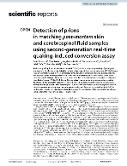Detection of prions in matching post-mortem skin and cerebrospinal fluid samples using second-generation real-time quaking-induced conversion assay

Author
Publication date
2024Published in
Scientific ReportsVolume / Issue
14 (March)ISBN / ISSN
ISSN: 2045-2322ISBN / ISSN
eISSN: 2045-2322Funding Information
MSM//LX22NPO5107
FN/V-FN/V-VFN
MZ0/NV/NV18-04-00179
MZ0/NU/NU23-04-00173
Metadata
Show full item recordCollections
This publication has a published version with DOI 10.1038/s41598-024-56789-6
Abstract
Real-time quaking-induced conversion assay (RT-QuIC) exploits templating activity of pathogenic prion protein for ultrasensitive detection of prions. We have utilized second generation RT-QuIC assay to analyze matching post-mortem cerebrospinal fluid and skin samples of 38 prion disease patients and of 30 deceased neurological controls. The analysis of cerebrospinal fluid samples led to 100% sensitivity and 100% specificity, but some samples had to be diluted before the analysis to alleviate the effect of present RT-QuIC inhibitors. The analysis of the corresponding skin samples provided 89.5% sensitivity and 100% specificity. The median seeding dose present in the skin was one order of magnitude higher than in the cerebrospinal fluid, despite the overall fluorescent signal of the skin samples was comparatively lower. Our data support the use of post-mortem cerebrospinal fluid for confirmation of prion disease diagnosis and encourage further studies of the potential of skin biopsy samples for intra-vitam prion diseases' diagnostics.
Keywords
Prions/metabolism, Prion Diseases/diagnosis, Skin/metabolism, Prion Proteins, Biological Assay, Creutzfeldt-Jakob Syndrome/diagnosis/cerebrospinal fluid
Permanent link
https://hdl.handle.net/20.500.14178/2546License
Full text of this result is licensed under: Creative Commons Uveďte původ 4.0 International







